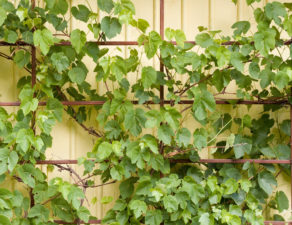
Do you ever dream of living in a vineyard? Or perhaps you just enjoy learning to grow new foods. If grapes are next on your list of gardening skills to explore, check out the following guide to get started.
Build a support structure. Grape vines need support as they grow, so your first task is to build a trellis or arbor. Choose a spot that receives at least seven to eight hours of sun each day. Where possible, shoot for about five feet between rows of vines, and provide 50 to 100 square feet of trellis space for each vine.
Amend your soil. Grapes can grow in a variety of soil types, but will do best in rich, well-drained organic soil. Mix ample compost deep into your soil, and ensure that the area will not retain water. Grapes cannot tolerate excess moisture. Provide for ample air circulation on all sides of your grapevine area, to prevent fungal diseases.
Choose a grape variety. You can choose from three main types of grapes – American, European, and Muscadine. Hybrids of these varieties are also available. Some prefer cooler environments while others thrive in the heat, so pay close attention to growing recommendations. The best way to ensure success is to first choose a grape variety that will thrive in your climate.
Remember that some grape vines are ornamental only, and do not produce fruit. Choose carefully to get the results you want.
Prune. Once your grape vines are established and trained to their trellis, it’s time to implement a pruning schedule. Grapes produce on vines that are a year old, so you must continue to prompt new growth. Prune your grape vines twice per year, once during their dormant phase and then once in the spring or summer.
Feed and protect your vines. Grape vines require only minimal amounts of fertilizer. Apply a light 10-10-10 or 10-20-20 fertilizer in early spring only. Watch for signs of powdery mildew and spray for it immediately if you see signs of the problem developing. Cover your vines with netting to protect the fruit from birds, who are notoriously destructive to this crop.
Harvest your grapes. Grapes are ready to harvest when they are richly colored, juicy, and full of flavor. Try a few to test them! If your grapes are slow to ripen, pinch back foliage to allow more light to the fruit.
After producing, grape vines will change color and lose their leaves annually. Don’t worry! This is normal, and your grape vines will be back in full force for the next growing season.
If you need assistance as you fit grape vines into your existing landscape, give us a call. We can help you choose a suitable location, offer advice on support structures, and answer any more questions you might have.








